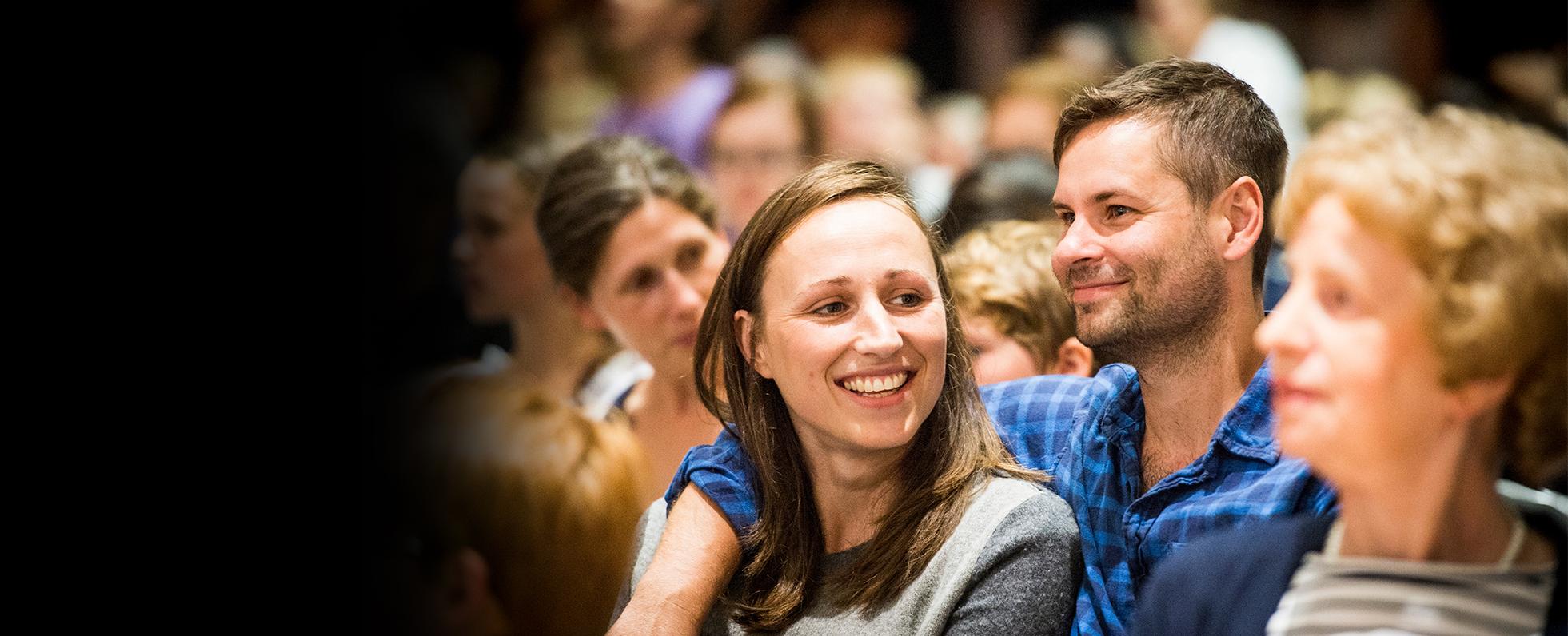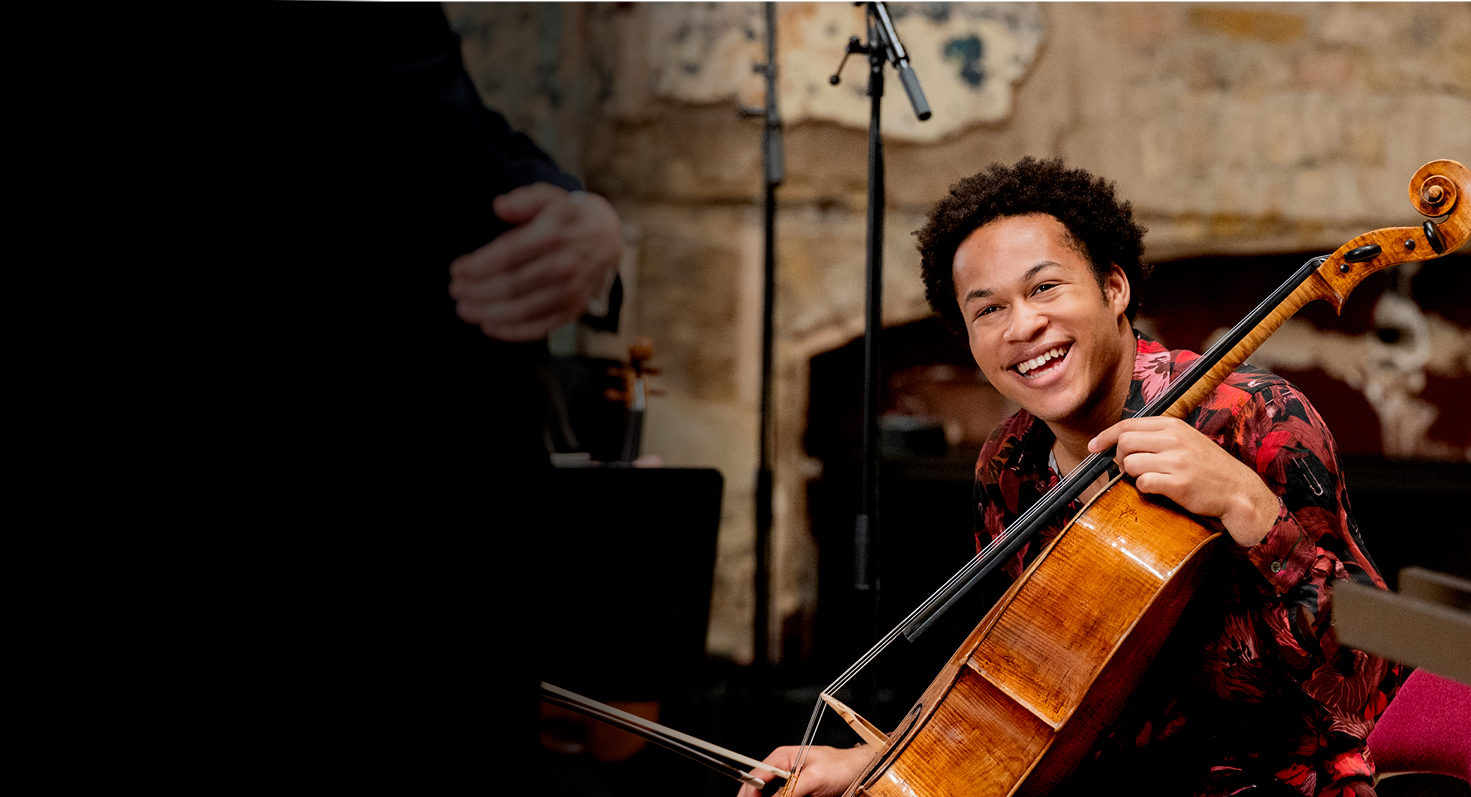Harp
The modern concert harp is very different in appearance from the instruments used centuries ago to accompany songs and those used today in folk music across the world such as the Irish harp.

Instrument: Harp
The Principal Harp Chair is endowed by Cliff and Jeannie Hampton.
Endowment opportunities at the Philharmonia offer supporters unique access and insights to our players. Find out more here:
Introduction
The concert harp sound is very similar to that of its relatives only more powerful and richer in tone. Although the harp has a long history it was not really used in orchestral music until the 19th century. What brought this about was the development of a pedalling system, which enabled the player to continually change the tuning whilst playing, turning the harp into a fully chromatic instrument. The harp is not a particularly loud instrument but the sound of its attack does penetrate, so composers often only use one with an orchestra or two with a larger orchestra.
The harp relies on 7 foot pedals to change the pitches of its 47 strings. They allow the harp to play chromatic notes but this also means that composers need to be aware of the need to allow sufficient time for pedal changes. Composers tend to use harps in a variety of ways: to support harmonies by playing chords; to add definition to the start of notes, phrases or bass lines – by providing a little ‘ping’ as another instrument begins to play and to create swirls of sound through glissandos – sweeping the hands across the strings in swift, flowing movements.
Notation
Because of the unique characteristics of the harp there are elements of the notation which are different, but essentially the harp is notated on two staves like the piano. Occasionally a composer will add pedal markings to the score (in particular for glissandos) but normally the harpist will work out their own pedalling. Harpists can play only four notes simultaneously in each hand, and 4 note chords must be close together as the stretches become difficult.
The hands to play particular notes can be marked m.d (main droite or right hand) or m.g (main gauche or left hand). Key changes and chromatic notes require planning by the harpist and they need a little time to change pedals if lots of chromaticism or a complicated key-changes are called for.
Unless specified a harpist will allow notes to ring until they have to be stopped (e.g. to change pedals). Certain effects characterise the harp’s sound, and can be very effective. Glissandos work very well, as do arpeggios and repeated figures, and harps can play tunesas long as any other instruments have quiet dynamics so the harp can be heard.
Did you know?
The neck of a harp is under considerable pressure. There is almost one tonne of tension in its strings.
Technique
The harp is played using the thumbs and first three fingers of each hand – harpists don’t use their little fingers as they’re not long enough. The fingers are played at an angle to the string and as the fingers come off they go into the palm of the hand. Chords on the harp are very common, but composers must be careful to make sure they fit within the hand span of the harpist.
Root chords and first and second inversions are very common, but wider intervals within chords are only possible between the thumb and first finger, and not between the first and second fingers.
On the harp, the trill is very different from say, a violin. Instead of alternating between two different notes a semitone apart, a harp trill is two strings, playing the same repeated note, over and over in quick succession. The result is that this kind of trill is much more resonant.
Feeling creative?
Download the Philharmonia Orchestra sound sample library, suitable for making any kind of music, no matter the style.
Construction
The harp is a unique instrument and many elements of how it is constructed bring light to how to play or write for the instrument. The modern harp has 47 strings and 7 pedals which raise or lower each pitch-class of strings. What that means is that the harp doesn’t have any ‘black notes’ like the piano but rather pedals which sharpen or flatten each string of the same pitch.
When the pedals are raised the strings are in their flat position and the pitches of the strings are: Cb, Db, Eb, Fb, Gb, Ab, Bb, etc. When the pedals are depressed to the middle position, turning pins stretch the string slightly, raising the pitch to a natural. Each pedal controls a different pitch so by altering the C pedal only you would have C, Db, Eb, Fb, Gb, Ab, Bb etc. Depressing the pedal further stretches the string even further, raising the pitch to C#, Db, Eb, Fb, Gb, Ab, Bb etc. Each pedal controls all the strings of that pitch (so by depressing the C pedal you change all the Cs on the harp.)
This means that harpists are constantly changing their pedal positions whilst playing the instrument and in the rests. Often they’ll have lots of changes to make, particularly if the piece changes key dramatically. For example if they were moving from D major (with the F and C pedals sharpened) to B major the harpist would have to sharpen 3 more sets of strings: G D and A. Pedal positions are marked in harp notation and you’ll often see harpists in an orchestra checking their pedals with their feet whilst watching the conductor for their entry: if the pedals are wrong then the audience would definitely notice!
The pedals are designed with key changes in mind so that each additional sharp or flat comes on the opposite side of the harp.
Harp strings are made of metal gut and sometimes nylon, and are coloured to give the player a visual aid to find the right string, with all the Cs red and all the Fs black. The lowest strings are made from steel and the rest of the strings are made from gut, although some players use nylon strings for the very highest notes, as gut strings tend to break more often.
About an hour before a concert you’ll see the harpists on stage tuning their harps – with 47 strings it can take a long time!
Range
The range of the harp is from C1 to G7, and the ranges fall as follows:
The Low Register: At the bottom of the harp single notes or chords work well, but running notes just become a blur because this area is so resonant.
The Central Register: The central register resonates beautifully and arpeggios and short running notes as well as chords fit perfectly in this register.
The High Register: At the top of the harp short running notes are better than chords or long single notes because this area is much less resonant and the notes don’t ring.
Frequency Range
58 Hz – 6.6 kHz
Dimension
6’1
More about the harp

Pictures at an Exhibition Listening Guide
Join us on Instagram
Keep up to date about online concerts, behind the scenes content and much more

Keep up to date
Sign up for email updates and be the first to receive stories, films and concert announcements

Support the Philharmonia
Enjoyed this content? We need your help to keep these resources free


